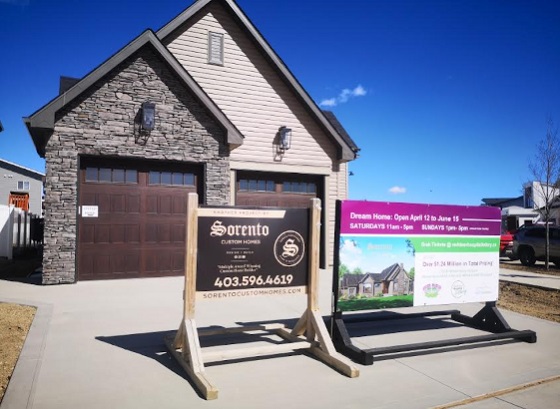Alberta
Writ drops for Alberta provincial election on May 29

United Conservative Party Leader Danielle Smith, centre, speaks at a campaign launch rally in Calgary, on Saturday, April 29, 2023. Smith is expected to call a provincial election during an announcement later this morning in Calgary. THE CANADIAN PRESS/Jeff McIntosh
Calgary
Writs issued for the 2023 Provincial General Election
Alberta’s Chief Electoral Officer, Glen Resler, confirms that Writs were issued today to administer elections across Alberta. The 31st Provincial General Election will be held on May 29, 2023.
Alberta’s Chief Electoral Officer, Glen Resler, confirms that Writs were issued today to administer elections across Alberta. The 31st Provincial General Election will be held on May 29, 2023.
“We are excited to welcome Albertans back to the polls this month,” said Resler. “Returning Officers have been appointed, and we are in the process of recruiting and training nearly 20,000 Election Officers to conduct voting in the 87 electoral divisions across the province.”
Voter Eligibility
Canadian citizens who reside in Alberta and are at least 18 years of age or older on Election Day are eligible to vote in the Provincial General Election.
Voter Registration
Electors may register to vote online at www.voterlink.ab.ca until May 17, 2023, by contacting Elections Alberta or their local returning office before 4:00 p.m. on Saturday, May 20.
Electors can also register to vote at any advance voting location in Alberta or at their assigned voting place on Election Day.
Electors who are already registered to vote at their current address do not need to register again.
Voter Identification
To vote in the 2023 Provincial General Election, electors are required to prove their identity and current address. There are several ways to do this, including:
- Providing one piece of Government-issued photo ID, including the voter’s full name, current address, and a photo.
- Providing two pieces of ID, both containing the voter’s full name and one that lists their current physical address.
- Having another registered elector with identification that resides in their voting area vouch for them.
- Having an authorized signatory complete an attestation form.
More than 50 different types of identification have been authorized by the Chief Electoral Officer to be used as identification to vote.
Key Timelines
Electors have 28 days to vote by Special Ballot beginning today. Special Ballots may be completed in the returning office, picked up by a designate of the elector, or mailed to the elector anywhere in the world. Applications can be submitted online on the Elections Alberta website.
Candidate nominations are now open and end on May 11, 2023, at 2:00 p.m.
Advance voting begins on Tuesday, May 23, 2023, and ends on Saturday, May 27, 2023.
Election Day is Monday, May 29, 2023. All voting places will be open from 9:00 a.m. to 8:00 p.m.
Unofficial results will be available after voting closes on Election Day.
Official results will be announced on June 8, 2023, at 10:00 a.m.
Returning Offices
Returning offices in all electoral divisions open today across Alberta. Returning offices are open on weekdays from 9:00 a.m. to 6:00 p.m., Saturdays from 10:00 a.m. to 4:00 p.m., and on Voting Days from 9:00 a.m. to 8:00 p.m. Returning Office addresses and contact information can be found at: https://elections.ab.ca/
New for 2023, Satellite Offices are also being opened in six geographically large electoral divisions to provide more service options for electors. These include:
- 54 – Cardston-Siksika
- 55 – Central Peace-Notley
- 59 – Drumheller-Stettler
- 60 – Fort McMurray-Lac La Biche
- 77 – Peace River
- 80 – Rimbey-Rocky Mountain House-Sundre
Satellite Offices are open on Tuesdays and Thursdays from 9:00 a.m. to 6:00 p.m., Saturdays from 10:00 a.m. to 2:00 p.m., and on Voting Days from 10:00 a.m. to 8:00 p.m.
For any questions or concerns regarding the provincial election, visit www.elections.ab.ca, call 1-877-422-VOTE, or email [email protected].
Information for media will be available throughout the election period at https://www.elections.ab.ca/
- Information sheets on topics such as Registering to Vote, Voter Identification, Accessible Voting and Tabulators and Voter Assist Terminals.
- Photo and video assets.
- Processes for accessing a voting place on voting days.
Elections Alberta is an independent, non-partisan office of the Legislative Assembly of Alberta responsible for administering provincial elections, by-elections, and referenda.
Alberta
Alberta Provincial Police – New chief of Independent Agency Police Service

Sat Parhar has been appointed as the first chief of the Independent Agency Police Service, marking the next step toward a new municipal policing option.
The appointment of a new chief for the Independent Agency Police Service (IAPS) marks the next step in giving municipalities a new option for local policing and builds on the work already underway for the agency to assume the police-like duties currently carried out by the Alberta Sheriffs. The IAPS will empower municipalities to adopt strategies that effectively respond to their specific safety concerns, enhancing public safety across the province.
Chief Parhar brings more than 25 years of policing experience, including senior roles with the Calgary Police Service, most recently as deputy chief. His frontline policing experience and deep understanding of Alberta’s complex and diverse public safety landscape positions him to lead the agency as it takes shape and begins its work as a new municipal policing option, keeping communities safe.
Once operational, the agency will strengthen Alberta’s existing policing model and complement the province’s current police services, which includes the RCMP, Indigenous policing services and municipal police. It will help fill gaps and ensure law enforcement resources are deployed efficiently to meet Alberta’s evolving public safety needs and improve law enforcement response times, particularly in rural communities.
“Appointing Chief Sat Parhar is a key milestone in Alberta’s plan to give municipalities a real choice in how their communities are kept safe. This is about building a modern police service that reflects the priorities of Albertans, strengthens local decision-making, and ensures every corner of our province, especially rural areas, can count on responsive, effective law enforcement. With his decades of experience and deep understanding of Alberta’s policing landscape, he is the right leader to bring this vision to life.”
“This appointment signifies a significant step forward in our efforts to establish a more robust, community-focused policing model that is better equipped to meet the unique needs of our local residents. Under Chief Parhar’s visionary leadership, we are confident that we will develop a modern, efficient police service that not only enhances public safety but also aligns closely with the priorities and values of Albertans. His experience and commitment are vital in shaping an IAPS that is responsive, transparent, and dedicated to fostering trust and collaboration within the community, ultimately ensuring a safer and more connected society for all.”
Chief Parhar’s immediate priorities will be to hire an executive team and commence organizational planning such as developing key recruitment, training and other operational policies. Chief Parhar’s appointment is the first step of many to establishing the IAPS.
“It’s an honour to take on this role and help shape a modern police service built for Alberta. My focus from day one will be on setting high standards for professionalism, building strong relationships with our partners and ensuring this service reflects the needs and priorities of the communities we serve.”
The Independent Agency Police Service was formally created through regulation following the passing of Public Safety Statutes Amendment Act, 2024. The agency will operate as an independent Crown corporation, and will be renamed the Alberta Sheriffs Police Service, with its head office located in Calgary. The IAPS will be operationally independent from the provincial government with civilian oversight, consistent with all police services in Alberta.
“When it comes to policing, municipalities like ours deserve a choice – especially when the current system leaves us disadvantaged simply because of our size. We look forward to learning more about what that alternative will look like once an Alberta police agency is fully established and the options are clear. For us, this is about fairness, sustainability, and ensuring municipalities have access to policing solutions that reflect both their needs and their realities.”
Quick facts
- The regulation establishes the IAPS Provincial Corporation and its governance structure including board of directors, board of director powers, financial responsibilities and accountabilities.
Related news
- Expanding municipal police service options (April 7, 2024)
Alberta
Pierre Poilievre – Per Capita, Hardisty, Alberta Is the Most Important Little Town In Canada

From Pierre Poilievre
-

 Health2 days ago
Health2 days agoRFK Jr. Unloads Disturbing Vaccine Secrets on Tucker—And Surprises Everyone on Trump
-

 Crime2 days ago
Crime2 days agoNational Health Care Fraud Takedown Results in 324 Defendants Charged in Connection with Over $14.6 Billion in Alleged Fraud
-

 Business1 day ago
Business1 day agoElon Musk slams Trump’s ‘Big Beautiful Bill,’ calls for new political party
-

 Censorship Industrial Complex1 day ago
Censorship Industrial Complex1 day agoGlobal media alliance colluded with foreign nations to crush free speech in America: House report
-

 International22 hours ago
International22 hours agoCBS settles with Trump over doctored 60 Minutes Harris interview
-

 Business14 hours ago
Business14 hours agoLatest shakedown attempt by Canada Post underscores need for privatization
-

 Business14 hours ago
Business14 hours agoWhy it’s time to repeal the oil tanker ban on B.C.’s north coast
-

 Alberta14 hours ago
Alberta14 hours agoPierre Poilievre – Per Capita, Hardisty, Alberta Is the Most Important Little Town In Canada






